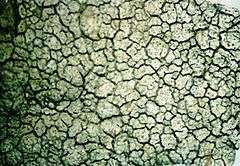Aspicilia cinerea
Aspicilia cinera (cinder lichen) is a gray to almost white, 1.5 – 15 cm wide, crustose areolate lichen with large apothecia that mostly grows on rock in the mountains.[1][2]:224 It grows in variable forms, from having a continuous surface to being areolate.[2]:224 It grows in Eurasia, and North America on siliceous rock, schist or igneous rock in habitats exposed to sunlight, also rarely on calciferous rock.[1] It is common in Arizona, and rare in California and Baja California at elevations of 1,700 to 3,300 metres (5,600 to 10,800 ft).[1]
| Aspicilia cinerea | |
|---|---|
 | |
| Aspicilia cinerea | |
| Scientific classification | |
| Kingdom: | |
| Division: | |
| Class: | |
| Order: | |
| Family: | |
| Genus: | |
| Species: | A. cinera |
| Binomial name | |
| Aspicilia cinera | |
| Synonyms | |
| |
Flat to almost convex areoles are angular to irregular, and 0.2 – 2 mm in diameter.[1] They are contiguous but clearly separated by well defined cracks.[1] It usually lacks a prothallus.[1] It may be rimose toward the outer edges.[1] Each areole has 1 – 10, round to angular or irregular, 0.1 -1.6 mm apothecia that may be confluent when numerous.[1] Apothecia have usually black concave discs, with exciple margins of thallus tissue.[1] Asci are club shaped (clavate), with 8 ellipsoid ascospores.[1]
Lichen spot tests on the cortex and medulla are K+ red, KC-, P+ yellow[2]:224 or P+ orange,[1] with the medulla sometimes testing K+ yellow and P+ orange.[2]:224 Secondary metabolites include norstictic acid and often connorstictic acid in traces, and more rarely hyposalazinic acid.[1]
The photobiont is a chlorococcoid.[1]